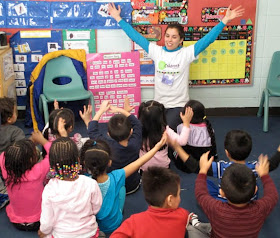Did you know that the Museum’s 2012-13 AmeriCorps team:
- Facilitated imaginative activities that celebrate diversity to help improve school readiness for more than 1,000 Head Start preschoolers
- Engaged over 500 elementary school-aged children with inspiring play-based math and science activities during after-school and summer Learning Clubs
- Welcomed more than 1,300 low-income children and family members to free Museum family nights, where they received complimentary year-long admission passes
- Recruited and trained dozens of Museum volunteers
- Engaged Museum visitors in hands-on exhibits and developed interactive public programs
- And much more!
Some heartfelt tributes shared during their graduation ceremony:
“[These children are] lucky if they meet someone who challenges their hearts and brains and changes the way they think. You might be that person.”
– Mary Ellen O'Mahony, Children’s Friend“Thank you for dedicating a year of your lives. It’s the best example of communities and people coming together to make the world a better places… leveling the playing field for these children and giving them the opportunities they deserve.”
– Marisa Petreccia, Serve Rhode Island“We could not reach these children in these numbers and with this depth without you…What would be the point of having a children’s museum if we couldn’t reach the children who need us most?”
– Janice O’Donnell, Museum directorOur sincere thanks and congratulations to Alex, Alexandra, Amanda, Ashley, Bridget, Dylan, Francesca, Jack, Kaylor, Kayshia, Leah, Mandy, Megan, Ryan, Samantha and Sarah!
The Museum’s AmeriCorps program is made possible by a grant from the Corporation for National and Community Service and Serve Rhode Island with additional support from Bristol County Savings Charitable Foundation; The John Clarke Trust, Bank of America, N.A., Co-Trustee; CVS Caremark Charity Classic; Frank B. Hazard General Charity Fund, Bank of America, N.A., Trustee; Harry M., Miriam C. & William C. Horton Fund, Bank of America, Co-Trustee; Museum Annual Campaign Donors; Sovereign Bank Foundation; Textron Charitable Trust; and UnitedHealthcare of New England.





















